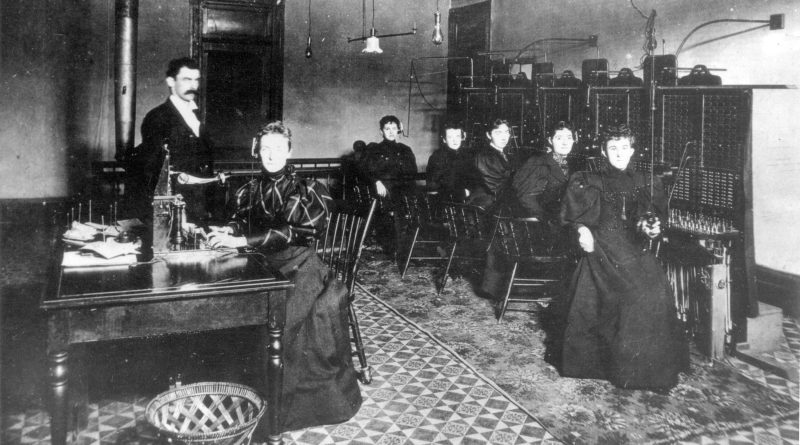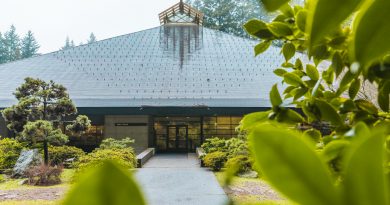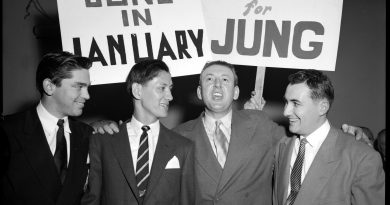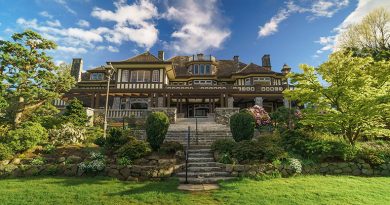1905 -1908
Above: B.C. Telephone Company staff at switchboards in office in Lefevre Block
[Image: Vancouver City Archives]
*****************************************
You’ll note that these years include events listed under “Also in . . .” These are events for which we don’t have a specific date. If YOU know the specific date of an event shown there, please notify us . . . and cite the source! Many thanks!
*****************************************
1905
April 16 The Police Mutual Benefit Association of Vancouver was organized.
April 18 San Francisco earthquake and fire.
May 1 The telephone came to North Vancouver, and that made a difference to the ferry system: until the ferry terminal hooked up to the telephone line the wharfinger used a system of calls with a bugle to let consignees know when their goods arrive. Two toots for McMillan’s, three for Larson’s Hotel, a long and two shorts for the Express (newspaper) and two long toots for the butcher.
June 1 The Vancouver Athletic Club opened.
June 2 Province Page 3 had an advertisement for the Opera House, which is showing “moving pictures” of the San Francisco earthquake and fire.
June 6 The Vancouver Board of Trade complained re “execrable” telephone service.
July 3 Chief Capilano of the Squamish Nation went to London to meet King Edward VII and Queen Alexandra. The chief, accompanied by Cowichan and Cariboo chiefs, presented a petition to the King concerning aboriginal land rights. Chief Capilano later reported the delegation was warned such matters might take as much as five years to settle.
July 21 The Chehalis was sunk by the Princess Victoria near Brockton Point. Eight lives were lost.
August 13 The owners of all houses on Dupont Street were given thirty days to put a stop to their activities. (Brothels.) But by the end of October the brothels were back in operation.
August 15 Electricity became commonly available to North Vancouver after a cable was laid across the Second Narrows.
August 22 Vancouver’s Canadian Club was formed. An inaugural luncheon was held September 25 at the Hotel Vancouver with Governor General Earl Grey as guest of honor.
September 3 Street cars began operation in North Vancouver, will serve the area for 40 years. From the ferry wharf one line went along Queensbury Avenue to 19th Street, one up Lonsdale to 21st Street, and another west to Keith Road and Bewicke Avenue.
December 24 Howard Hughes born.
Also in 1906
A young man named Ernest Poole built a farmhouse in his hometown of Stoughton, Saskatchewan, his first construction job. He built his company into one of Canada’s largest, PCL Construction. The company has been active for decades in BC. Check out this web site.
Al Jolson, 20, performed at the Grand Theatre.
Construction began on the provincial court house at 800 West Georgia (home today to the Vancouver Art Gallery).
David Spencer opened his first store.
Alfred Wallace opened a shipyard in North Vancouver. Under various names (Burrard Dry Dock, Versatile Pacific, etc.) it will become the north shore’s largest industry, building scores of ships during both World Wars.
Richmond’s school districts merged and a Richmond School Board was formed.
There was another huge salmon run this year. About this time the Smith butchering machine was introduced. It took the place of a 30-man gang of Chinese cannery workers, and will come to be nicknamed the “Iron Chink.”
The Vancouver Stock Exchange was incorporated. 1907 also cited.
1906 Buick Model G “Turtle Deck”
1907
February 2 Surrey’s John Oliver became leader of the opposition in B.C.’s legislature after the first provincial election to be run on party lines.
February Henry Birks & Sons of Montreal, the famed jewellers, bought out George Trorey’s jewelry store at the northeast corner of Granville and Hastings and kept Trorey on as manager. The Trorey Clock on the sidewalk outside will become a Vancouver landmark as the Birk’s clock. It’s still ticking away at Granville and Hastings a century later . . . on the southeast corner!
April 12 The Vancouver Stock Exchange was incorporated by an act of the Provincial legislature. BC Archives has 1906.
May 7 A Seattle movie-maker, William Harbeck, mounted a camera on the front of a B.C. Electric Railway tram and filmed the journey along Granville and Hastings, along Westminster Avenue (now Main Street) and Carrall, Powell, Cordova and Cambie, Robson and Davie . . . a look at a Vancouver of a century ago.
This is the earliest surviving film on Vancouver. Its discovery was something of a miracle: it was found in the basement of an abandoned building in Australia! It had apparently been dumped there by movie house managers along with other movies no longer wanted.
It is fun and exciting to see streets full of horse-drawn wagons, men (every one of them wearing a hat) strolling into long-gone shops, women hurrying along in their dark, ground-length skirts, and the occasional recognizable sign: Knowlton Drugs; P. Burns (meat packer); the Edison Grand Theatre; Woodward’s, and “Cascade: A Beer Without Peer.””Gone is the second CPR station at the foot of Granville, and Trorey’s Jewelry and the original Province newspaper building.
We can thank the research efforts of Andrew Martin, of the Special Collections division at the Vancouver Public Library, for pinpointing when the film was made. He’d found a Province story, dated May 8, 1907, that described the filming. It jauntily reported that Vancouverites had been “Stricken with Kinetoscopitis.” We learned that Seattle’s W.H. Harbeck shot the film, that it was taken May 7, 1907, and that it was shot with the cooperation of Mr. W.E. Flumerfelt of the Tourist Association. The journey ended at a spot on Davie just about where the Fresgo Inn sits today.
Copies of this film are available for loan at the Vancouver Public Library. A fine experience.
May 11 The University Women’s Club of Vancouver was founded by eight graduates.
May 13 The small, central core of North Vancouver’s business and industry broke away and formed its own municipality, the City of North Vancouver. The residents felt their area would be more prosperous on its own. The District was deprived of its water system, municipal hall, ferry terminal and ferry, fire-fighting and road-making equipment, even the cemetery. In return the City paid some outstanding liabilities of the District.
May 31 A dozen Vancouver businessmen formed the Vancouver Exhibition Association, with a goal of developing a fair to showcase Vancouver to the world.
Spring John Lawson, known as the “Father of West Vancouver” settled his family in Navvy Jack Thomas’ house, which became known as Hollyburn. Lawson would later be instrumental in getting West Vancouver to secede from North Vancouver (1912).
June 10 The newly constituted District of North Vancouver held its first meeting in Lynn Valley Schoolhouse. A new municipal hall, on Lynn Valley Road, would be completed in 1911.
June 13 The Presbyterian theological college, Westminster Hall, was founded.
June 24 Formation of Jericho Country Club.
August 1 The Vancouver Stock Exchange opened at 849 West Pender with 12 charter members. Three months to the day later its president, C.D. Rand, said: “Many applications to list stocks of doubtful merit have already been made to the Exchange, but have been promptly turned down by your executive, and this policy will be adhered to while we remain in office.”
August 8 Train robber Bill Miner escaped from the penitentiary in New Westminster.
August 14 The first newspaper reference to the Vancouver Police Department’s first automobile. The car got its first use exactly one week later: on August 21 one Richard Goddlander, “a well-known police character,” was charged with public intoxication and given his first automobile ride. Destination: the city jail.
September 7 The News-Advertiser reported that an Asiatic Exclusion League had been formed in Vancouver to keep Oriental immigrants out of B.C. The Province reported on “Saturday night excitement” in town, namely an anti-Oriental riot September 7th led by the Anti-Asiatic League, a racist group formed to try to force Chinese and Japanese workers out of the province. “The Chinese of Vancouver armed themselves this morning as soon as the gun stores opened. Hundreds of revolvers and thousands of rounds of ammunition were passed over the counter to the Celestials before the police stepped in and requested that no further sale be made to Orientals . . . Few Japanese were seen buying arms, but a bird’s-eye view today of the roofs of Japanese boarding-houses and stores in the Japanese district disclosed the fact that the Orientals are prepared for a siege. Hundreds of bottles are stored on the roofs, and these with stones, clubs, and bricks will be hurled at the whites in the streets below should any further trouble occur.”
September 12 Just five days after it was formed the Asiatic Exclusion League was disbanded.
September 30 Vancouver city council was discussing street names and decided to commemorate battles. So what had been Victoria Road became Point Grey Road, Campbell Street became Alma Road (Crimean War), Richards Street became Balaclava (also a Crimean War battlesite), Cornwall, the second street with that name, became Blenheim to recall the Battle of Blenheim, Lansdowne became Waterloo, and the old Boundary St. that divided District Lot 192 and the CPR grant became Trafalgar.
October 5 Rudyard Kipling’s third and final visit to Vancouver.
October 14 The famous American band leader and composer John Philip Sousa performed here with his band—all 55 of them—and that would have set you back $1.75 for the best seats.
December 1 W.J. Timmins, proprietor of the new Pantages vaudeville theatre on Hastings Street, was up from Tacoma to “look over the work.” The 1,200-seat theatre was expected to open on December. 1.
December 6 The first recorded flight in Canada of a heavier-than-air machine took place at Baddeck, N.S. when Thomas Selfridge was lifted into the air in a tetrahedral kite, the Cygnet, designed by Alexander Graham Bell.
Also in 1907
Alexander Bethune, a shoe merchant, was mayor. He had been an alderman for five years. During Bethune’s term, council asked the federal government for use of the Kitsilano Indian Reserve for city purposes.
Mackenzie King, the federal Deputy Minister of Labour, visited Vancouver to review damage caused by the anti-Oriental riots. He was dismayed to learn the manufacture of opium here was legal.
Firehall No. 6 was built at 1001 Nicola.
Firehall No. 2 was built at 270 East Cordova.
Douglas Lodge was built at 2799 Granville. Local historian John Atkin, who knows this subject well, says he has the building permit reference for the building which lists it as a $200,000 project. The permit is dated September 1912. John thinks the 1907 reference seen frequently is incorrect. And in trolling the Internet he found the following—which he cautions he has not verified: “Built in 1912, Douglas Lodge has been home to many famous people. The hilarious John Candy lived here for a long time, as did Ted Danson from Cheers. So did the parents of renowned Vancouver-born architect Arthur Erickson . . . When former Prime Minister Pierre Trudeau passed away, his son Justin Trudeau was residing at Douglas Lodge. And Emily Carr gave painting lessons there to a friend who rented an apartment inside.” That excerpt was written by Kent Hurl – check out Kent’s blog here. [Note: Our guess is that Danson’s tenancy was connected with the 1989 filming of Cousins. Another famous tenant, no longer there: Sarah McLachlan.]
(1907 date estimated) The first gas station in Canada opened at Cambie and Smithe Streets. Sometime around 1907 it occurred to the Vancouver office of the Imperial Oil Co. that the usual method of fueling automobiles at the time—carrying a sloshing bucket full of gasoline up to the vehicle and pouring it through a funnel into the tank—was somewhat dangerous. So, adjacent to the storage yard, the manager of Imperial’s Vancouver office, Charles Rolston, built a small open-sided shed of corrugated iron. Atop a tapering concrete pillar he placed a 13-gallon kitchen water tank “fitted with a glass steam-gauge marked off by white dots in one-gallon increments.” The tank was gravity fed, being connected to Imperial’s main storage tank. The filling hose was a ten-foot length of garden hose, drained with thumb and finger by the attendant after filling a car. The first attendant was Imperial’s former night watchman, J.C. Rollston (no relation to Charles Rolston), who had been in poor health. His coworkers believed he would improve in the sun and open air. They bought a barroom chair for him and set him down. Canada’s first gas station was now in business. The late city archivist, J.S. Matthews (who worked for Imperial Oil at the time) said that, in the beginning, a busy morning would see three or four cars show up.
Japanese residents of Vancouver built an arch to honor the visit of His Imperial Highness Prince Fushimi.
The first community hall in Surrey, Tynehead Hall, was built.
Dominic Burns built a slaughterhouse this year in Vancouver. (It was torn down in 1969 and the man in charge of the demolition said it was the toughest building to destroy he had ever seen. One item: the brick walls were 36 centimetres (14 inches) thick.)
B. T. Rogers (the sugar refiner) donated a pair of marble statues to the Terminal City Club. They’re still there.
Richard Cormon Purdy opened his first chocolate shop on Vancouver’s famed Robson Street. Today, Purdy’s—run by Karen Flavelle—has more than 50 locations in B.C., Alberta and Ontario.
The chief of the Vancouver Fire Department, John Howe Carlisle, arranged to have three motorized firefighting units purchased, in the face of some amused, some not-so-amused, opposition. His was a daring move, in fact. The company making these units–Seagrave of Columbus, Ohio–had just begun their manufacture, and very few fire departments in North America were making the switch. Vancouver’s was the first in Canada.
The Vancouver Daily Province had a circulation of just over 15,000, highest in town, and cost five cents.
William H. Ladner, the well-known Delta pioneer (and reeve from 1880 to 1906) died at 81. Ladner was named for him.
1908
March 19 The first Vancouver Horse Show was held at the Drill Hall.
May 16 This advertisement appeared on Page 12 of the Vancouver News-Advertiser: “Manager George Calvert, of the Pantages Theatre, takes great pleasure in announcing that there will be an extra act on the bill this afternoon and this evening, namely ‘Jeff,’ the Boxing Kangaroo. This animal is claimed to be an adept in the boxing line, in fact almost as good if not better than an ordinary boxer and he has proved a great attraction wherever he has appeared. This is an act that will greatly please the ladies and children and there should be a large turnout of them at all the performances to-day.”
June The first hospital to serve the north shore was opened, a tiny six-bed facility at St. Andrews and 15th Street.
September 9 The British Columbia Refining Company Ltd. in Port Moody was incorporated. It refined oil shipped from California.
September 20 The Rev. W.A. Davis conducted Sunday service in John Lawson’s home for a group of Presbyterians, Methodists, Baptists and Congregationalists.
November 1 The federal ministry of defence renewed the lease of Stanley Park to Vancouver for 99 years, renewable.
Also in 1908
Point Grey Municipality was formed.
The first tourist bus service in Stanley Park.
Shaughnessy Heights was subdivided by the CPR.
The sale of opium was prohibited.
Grand Boulevard in North Vancouver was cleared and planted with shrubs by the North Vancouver Land and Improvement Company. It was conveyed to the City of North Vancouver for parkland, around which a high class residential area was planned.
Members of the B.C. Mountaineering Club made the first known ascent of Mt. Seymour on the north shore.
Richmond built its first high school at Bridgeport. With four rooms, it was considered huge. The first graduating class will be in 1911.
The Surrey police force was formed, responsible for welfare issues, collecting poll and business taxes and investigating local crime.
The New Westminster Salmonbellies won their first national prize, the Minto Cup.
The largest agriculture fair ever held in the province was opened in New Westminster. By this time, Fraser Valley fruit was being canned and shipped all over the world.




